

Compact Muon Solenoid
LHC, CERN
| CMS-HIN-17-008 ; CERN-EP-2018-257 | ||
| Measurement of $\mathrm{B}^{0}_{\mathrm{s}}$ meson production in pp and PbPb collisions at $\sqrt {\smash [b]{s_{_{\mathrm {NN}}}}} = $ 5.02 TeV | ||
| CMS Collaboration | ||
| 6 October 2018 | ||
| Phys. Lett. B 796 (2019) 168 | ||
| Abstract: The production cross sections of $\mathrm{B}^{0}_{\mathrm{s}}$ mesons and charge conjugates are measured in proton-proton (pp) and PbPb collisions via the exclusive decay channel ${\mathrm{B}^{0}_{\mathrm{s}} \to \mathrm{J}/\psi \phi \to \mu^{+}\mu^{-}\mathrm{K^{+}}\mathrm{K^{-}}}$ at a centre-of-mass energy of 5.02 TeV per nucleon pair and within the rapidity range $| y | < $ 2.4 using the CMS detector at the LHC. The pp measurement is performed as a function of transverse momentum (${p_{\mathrm{T}}}$) of the $\mathrm{B}^{0}_{\mathrm{s}}$ meson in the range of 7 to 50 GeV/$c$ and is compared to the predictions of perturbative QCD calculations. The $\mathrm{B}^{0}_{\mathrm{s}}$ production yield in PbPb collisions is measured in two ${p_{\mathrm{T}}}$ intervals, 7 to 15 and 15 to 50 GeV/$c$, and compared to the yield in pp collisions in the same kinematic region. The nuclear modification factor (${R_{\mathrm{AA}}} $) is found to be 1.5 $\pm$ 0.6 (stat) $\pm$ 0.5 (syst) for 7-15 GeV/$c$, and 0.87 $\pm$ 0.30 (stat) $\pm$ 0.17 (syst) for 15-50 GeV/$c$, respectively. Within current uncertainties, the results are consistent with models of strangeness enhancement and a suppression as observed for the $\mathrm{B^{+}}$ mesons. | ||
| Links: e-print arXiv:1810.03022 [hep-ex] (PDF) ; CDS record ; inSPIRE record ; HepData record ; CADI line (restricted) ; | ||
| Figures | |
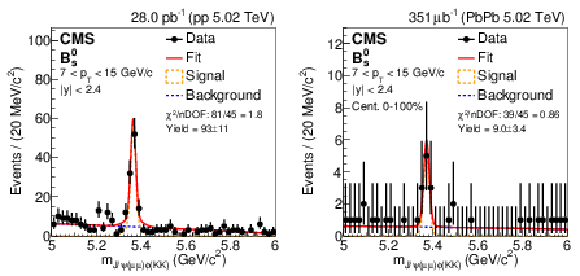
png pdf |
Figure 1:
Invariant mass distributions of $ {\mathrm {B}^0_\mathrm {s}} $ candidates in pp (left) and PbPb (right) collisions measured in the range $ | y | < $ 2.4 and in the ${p_{\mathrm {T}}}$ range of 7-15 GeV/$c$. The $\chi ^2$ divided by the number of degrees of freedom (nDOF) is also given. |
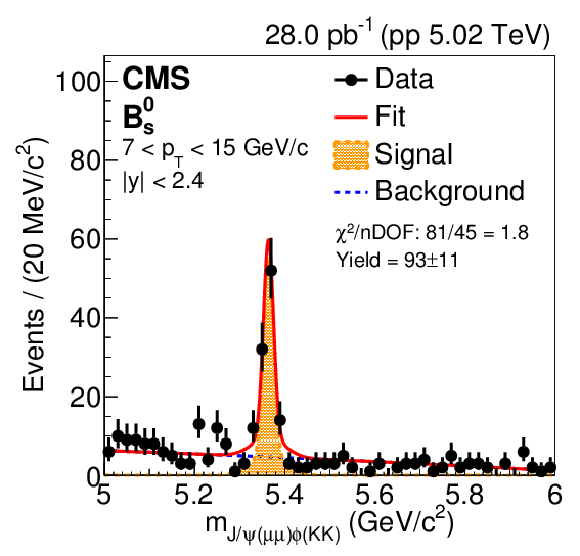
png pdf |
Figure 1-a:
Invariant mass distributions of $ {\mathrm {B}^0_\mathrm {s}} $ candidates in pp collisions measured in the range $ | y | < $ 2.4 and in the ${p_{\mathrm {T}}}$ range of 7-15 GeV/$c$. The $\chi ^2$ divided by the number of degrees of freedom (nDOF) is also given. |
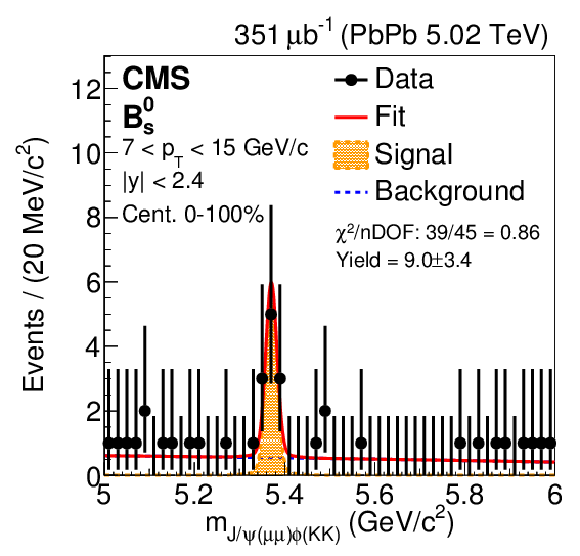
png pdf |
Figure 1-b:
Invariant mass distributions of $ {\mathrm {B}^0_\mathrm {s}} $ candidates in PbPb collisions measured in the range $ | y | < $ 2.4 and in the ${p_{\mathrm {T}}}$ range of 7-15 GeV/$c$. The $\chi ^2$ divided by the number of degrees of freedom (nDOF) is also given. |
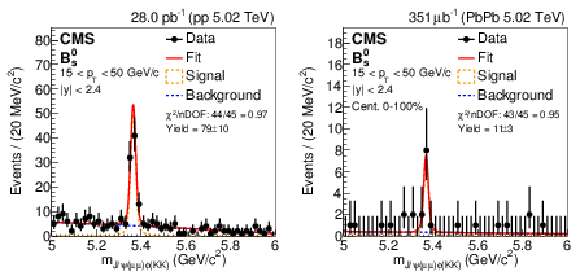
png pdf |
Figure 2:
Invariant mass distributions of $ {\mathrm {B}^0_\mathrm {s}} $ candidates in pp (left) and PbPb (right) collisions measured in the range $ | y | < $ 2.4 and in the ${p_{\mathrm {T}}}$ range of 15-50 GeV/$c$. The $\chi ^2$ divided by the number of degrees of freedom (nDOF) is also given. |
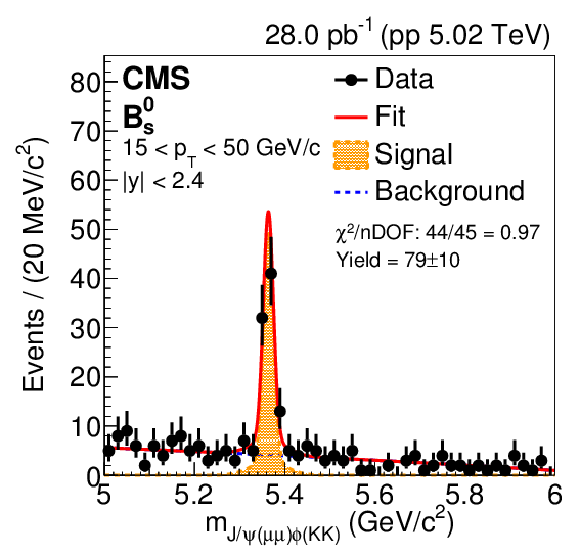
png pdf |
Figure 2-a:
Invariant mass distributions of $ {\mathrm {B}^0_\mathrm {s}} $ candidates in pp collisions measured in the range $ | y | < $ 2.4 and in the ${p_{\mathrm {T}}}$ range of 15-50 GeV/$c$. The $\chi ^2$ divided by the number of degrees of freedom (nDOF) is also given. |
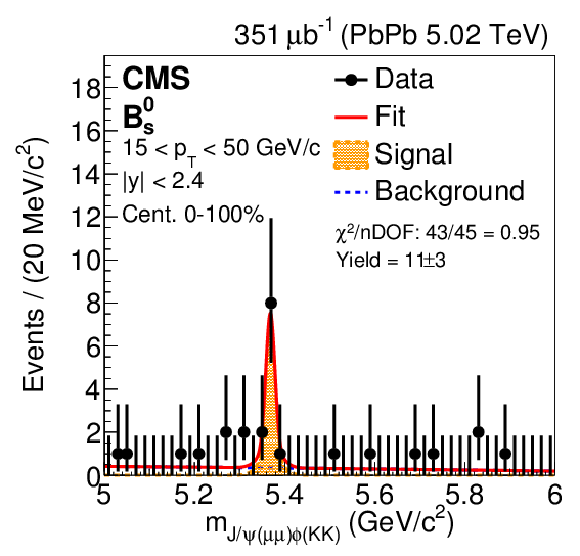
png pdf |
Figure 2-b:
Invariant mass distributions of $ {\mathrm {B}^0_\mathrm {s}} $ candidates in PbPb collisions measured in the range $ | y | < $ 2.4 and in the ${p_{\mathrm {T}}}$ range of 15-50 GeV/$c$. The $\chi ^2$ divided by the number of degrees of freedom (nDOF) is also given. |
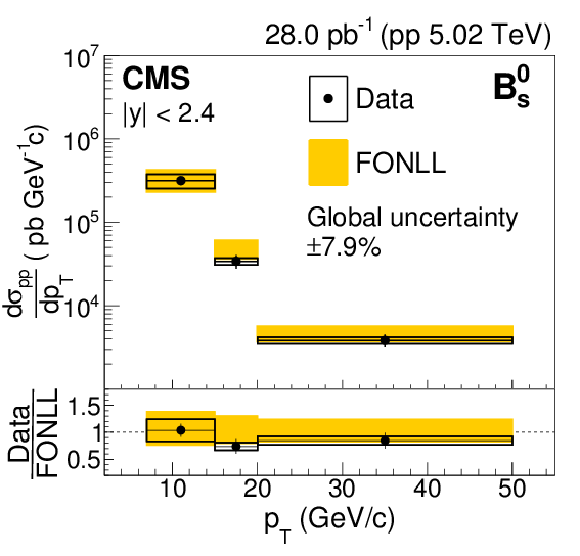
png pdf |
Figure 3:
The ${p_{\mathrm {T}}} $-differential production cross section of $ {\mathrm {B}^0_\mathrm {s}} $ in pp collisions at $ {\sqrt {s}} = $ 5.02 TeV in three ${p_{\mathrm {T}}}$ intervals from 7 to 50 GeV/$c$. The vertical bars (boxes) correspond to statistical (systematic) uncertainties. The systematic uncertainty boxes here include both the correlated and uncorrelated contributions added in quadrature. The global systematic uncertainty, listed in the legend and not included in the point-to-point uncertainties, comprises the uncertainties in the integrated luminosity measurement and in the branching fraction $\mathcal {B}$. The pp cross section is compared to FONLL calculations [28] represented by the colored yellow boxes with the heights indicating the theoretical uncertainty. |
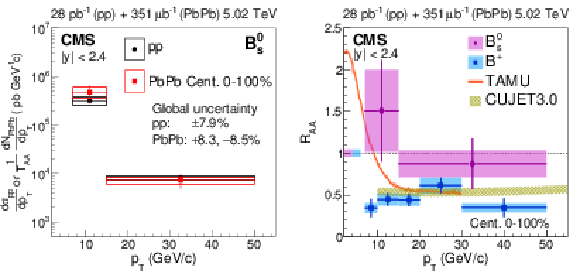
png pdf |
Figure 4:
(left) The ${p_{\mathrm {T}}} $-differential production cross section of $ {\mathrm {B}^0_\mathrm {s}} $ mesons in pp collisions and the ${p_{\mathrm {T}}} $-differential corrected yield of $ {\mathrm {B}^0_\mathrm {s}} $ mesons scaled by ${T_{\mathrm {AA}}}$ in PbPb collisions at $ {\sqrt {\smash [b]{s_{_{\mathrm {NN}}}}}} = $ 5.02 TeV in two ${p_{\mathrm {T}}}$ intervals from 7 to 50 GeV/$c$. The vertical bars (boxes) correspond to statistical (systematic) uncertainties. The systematic uncertainty boxes here include both the correlated and uncorrelated contributions added in quadrature. The global systematic uncertainty comprises the uncertainties in ${T_{\mathrm {AA}}}$, $N_{\text {MB}}$, and $\mathcal {B}$. (right) The nuclear modification factor ${R_{\mathrm {AA}}}$ of $ {\mathrm {B}^0_\mathrm {s}} $ measured in PbPb collisions at $ {\sqrt {\smash [b]{s_{_{\mathrm {NN}}}}}} = $ 5.02 TeV from 7 to 50 GeV/$c$. The vertical bars (boxes) correspond to statistical (systematic) uncertainties. The ${{\mathrm {B}^{+}}}$ ${R_{\mathrm {AA}}}$ measurement [29] is also shown for comparison. The global systematic uncertainty, represented by colored boxes at ${R_{\mathrm {AA}}} =$ 1, comprises the uncertainties in the integrated luminosity measurement and ${T_{\mathrm {AA}}}$ value. Two theoretical calculations are also shown for comparison: TAMU [49,19] and CUJET3.0 [46,47,48]. The line width of the theoretical calculation from Refs. [49,19] represents the size of its statistical uncertainty. |
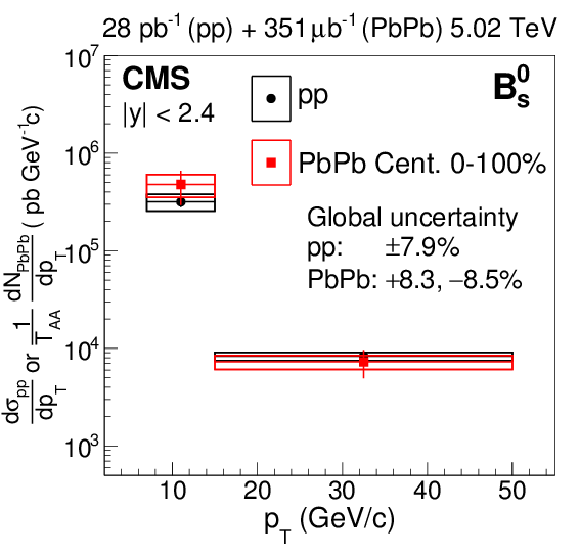
png pdf |
Figure 4-a:
The ${p_{\mathrm {T}}} $-differential production cross section of $ {\mathrm {B}^0_\mathrm {s}} $ mesons in pp collisions and the ${p_{\mathrm {T}}} $-differential corrected yield of $ {\mathrm {B}^0_\mathrm {s}} $ mesons scaled by ${T_{\mathrm {AA}}}$ in PbPb collisions at $ {\sqrt {\smash [b]{s_{_{\mathrm {NN}}}}}} = $ 5.02 TeV in two ${p_{\mathrm {T}}}$ intervals from 7 to 50 GeV/$c$. The vertical bars (boxes) correspond to statistical (systematic) uncertainties. The systematic uncertainty boxes here include both the correlated and uncorrelated contributions added in quadrature. The global systematic uncertainty comprises the uncertainties in ${T_{\mathrm {AA}}}$, $N_{\text {MB}}$, and $\mathcal {B}$. |
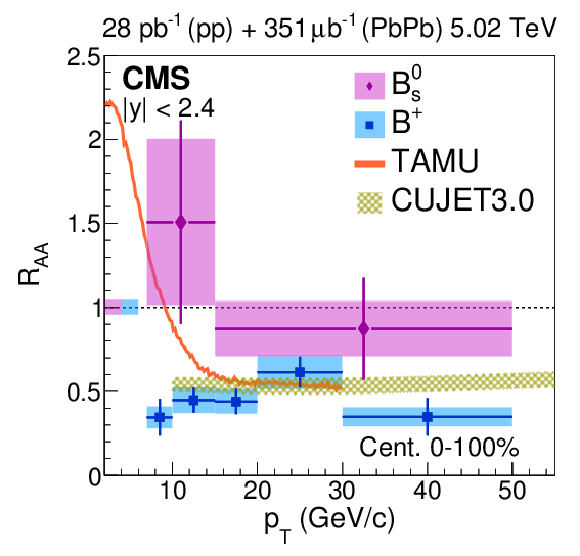
png pdf |
Figure 4-b:
The nuclear modification factor ${R_{\mathrm {AA}}}$ of $ {\mathrm {B}^0_\mathrm {s}} $ measured in PbPb collisions at $ {\sqrt {\smash [b]{s_{_{\mathrm {NN}}}}}} = $ 5.02 TeV from 7 to 50 GeV/$c$. The vertical bars (boxes) correspond to statistical (systematic) uncertainties. The ${{\mathrm {B}^{+}}}$ ${R_{\mathrm {AA}}}$ measurement [29] is also shown for comparison. The global systematic uncertainty, represented by colored boxes at ${R_{\mathrm {AA}}} =$ 1, comprises the uncertainties in the integrated luminosity measurement and ${T_{\mathrm {AA}}}$ value. Two theoretical calculations are also shown for comparison: TAMU [49,19] and CUJET3.0 [46,47,48]. The line width of the theoretical calculation from Refs. [49,19] represents the size of its statistical uncertainty. |
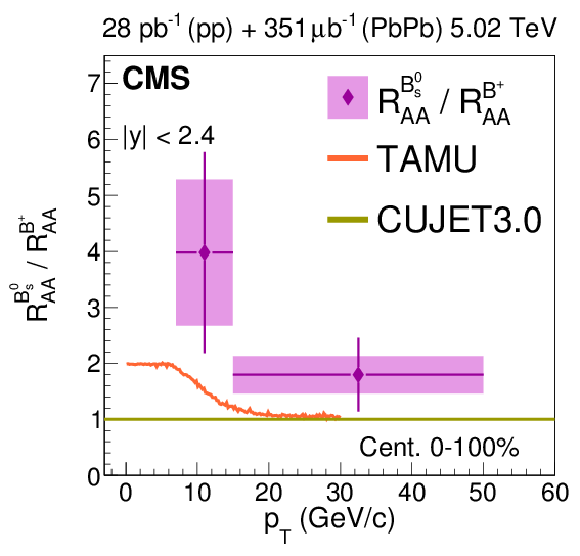
png pdf |
Figure 5:
Nuclear modification factor $\mathrm {{R_{\mathrm {AA}}}}$ ratio between $ {\mathrm {B}^0_\mathrm {s}} $ and $ {{\mathrm {B}^{+}}}$ measured in PbPb collisions at $ {\sqrt {\smash [b]{s_{_{\mathrm {NN}}}}}} = $ 5.02 TeV from 7 to 50 GeV/$c$. Two theoretical calculations are also shown for comparison: TAMU [49,19], and CUJET3.0 [46,47,48]. |
| Tables | |
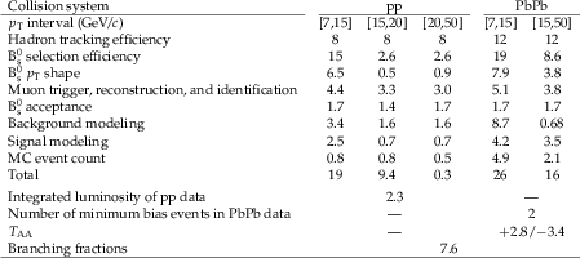
png pdf |
Table 1:
Summary of systematic uncertainties in percentage (%) from each factor in pp and PbPb analyses. |
| Summary |
| The first measurement of the differential production cross section of $\mathrm{B}^{0}_{\mathrm{s}}$ mesons (including both charge conjugates) in both pp and PbPb collisions at a centre-of-mass energy of 5.02 TeV per nucleon pair is presented. The $\mathrm{B}^{0}_{\mathrm{s}}$ and ${\mathrm{\overline{B}}^0}s$ mesons are studied with the CMS detector at the LHC in the rapidity range $| y | < $ 2.4 via the reconstruction of one of their exclusive hadronic decay channels, ${\mathrm{B}^{0}_{\mathrm{s}} \to \mathrm{J}/\psi \phi \to \mu^{+}\mu^{-}\mathrm{K^{+}}\mathrm{K^{-}}} $. The nuclear modification factor ${R_{\mathrm{AA}}}$ of $\mathrm{B}^{0}_{\mathrm{s}}$ is measured in the transverse momentum range from 7 to 50 GeV/$c$, inclusively for 0-100% event centrality. An indication of an enhancement of the $\mathrm{B}^{0}_{\mathrm{s}}$/$\mathrm{B^{+}}$ ratio in PbPb with respect to pp collisions is seen. More precise measurements of the $\mathrm{B}^{0}_{\mathrm{s}}$ and $\mathrm{B^{\pm}}$ mesons ${R_{\mathrm{AA}}}$ with the upcoming high-luminosity LHC heavy ion runs could provide further constraints on the relevance of recombination, a marker of deconfined matter, for beauty hadron production, and unambiguous information about the mechanisms of beauty hadronisation in heavy ion collisions. |
| References | ||||
| 1 | \'E. V. Shuryak | Theory of hadronic plasma | Sov. Phys. JETP 47 (1978)212 | |
| 2 | J. C. Collins and M. J. Perry | Superdense matter: neutrons or asymptotically free quarks? | PRL 34 (1975) 1353 | |
| 3 | F. Karsch and E. Laermann | Thermodynamics and in-medium hadron properties from lattice QCD | in Quark-Gluon Plasma III, R. Hwa (ed.), 2003 | hep-lat/0305025 |
| 4 | J. D. Bjorken | Energy loss of energetic partons in quark-gluon plasma: possible extinction of high $ {p_{\mathrm{T}}} $ jets in hadron-hadron collisions | Fermilab PUB 82-059-THY | |
| 5 | R. Baier, D. Schiff, and B. G. Zakharov | Energy loss in perturbative QCD | Ann. Rev. Nucl. Part. Sci. 50 (2000) 37 | hep-ph/0002198 |
| 6 | CMS Collaboration | Observation and studies of jet quenching in PbPb collisions at $ {\sqrt {\smash [b]{s_{_{\mathrm {NN}}}}}} = $ 2.76 TeV | PRC 84 (2011) 024906 | CMS-HIN-10-004 1102.1957 |
| 7 | ATLAS Collaboration | Observation of a centrality-dependent dijet asymmetry in lead-lead collisions at $ {\sqrt {\smash [b]{s_{_{\mathrm {NN}}}}}} = $ 2.76 TeV with the ATLAS detector at the LHC | PRL 105 (2010) 252303 | 1011.6182 |
| 8 | A. Andronic et al. | Heavy-flavour and quarkonium production in the LHC era: from proton-proton to heavy-ion collisions | EPJC 76 (2016) 107 | 1506.03981 |
| 9 | J. Rafelski and B. Muller | Strangeness Production in the Quark - Gluon Plasma | PRL 48 (1982) 1066, .[Erratum: \DOI10.1103/PhysRevLett.56.2334] | |
| 10 | STAR Collaboration | Strangeness enhancement in Cu+Cu and Au+Au collisions at $ {\sqrt {\smash [b]{s_{_{\mathrm {NN}}}}}} = $ 200 GeV | PRL 108 (2012) 072301 | 1107.2955 |
| 11 | STAR Collaboration | Strange and multi-strange particle production in Au+Au collisions at $ {\sqrt {\smash [b]{s_{_{\mathrm {NN}}}}}} = $ 62.4 GeV | PRC 83 (2011) 024901 | 1010.0142 |
| 12 | STAR Collaboration | Energy and system size dependence of phi meson production in Cu+Cu and Au+Au collisions | PLB 673 (2009) 183 | 0810.4979 |
| 13 | STAR Collaboration | Enhanced strange baryon production in Au+Au collisions compared to p+p at $ {\sqrt {\smash [b]{s_{_{\mathrm {NN}}}}}} = $ 200 GeV | PRC 77 (2008) 044908 | |
| 14 | STAR Collaboration | Scaling properties of hyperon production in Au+Au collisions at $ {\sqrt {\smash [b]{s_{_{\mathrm {NN}}}}}} = $ 200 GeV | PRL 98 (2007) 062301 | nucl-ex/0606014 |
| 15 | STAR Collaboration | Multistrange baryon production in Au-Au collisions at $ {\sqrt {\smash [b]{s_{_{\mathrm {NN}}}}}} = $ 130 GeV | PRL 92 (2004) 182301 | nucl-ex/0307024 |
| 16 | STAR Collaboration | Kaon production and kaon to pion ratio in Au+Au collisions at $ {\sqrt {\smash [b]{s_{_{\mathrm {NN}}}}}} = $ 130 GeV | PLB 595 (2004) 143 | nucl-ex/0206008 |
| 17 | STAR Collaboration | $ {\mathrm{K^{\ast}(892)}}^0 $ production in relativistic heavy ion collisions at $ {\sqrt {\smash [b]{s_{_{\mathrm {NN}}}}}} = $ 130 GeV | PRC 66 (2002) 061901 | nucl-ex/0205015 |
| 18 | ALICE Collaboration | Multi-strange baryon production at mid-rapidity in Pb-Pb collisions at $ {\sqrt {\smash [b]{s_{_{\mathrm {NN}}}}}} = $ 2.76 TeV | PLB 728 (2014) 216 | 1307.5543 |
| 19 | M. He, R. J. Fries, and R. Rapp | Heavy flavor at the large hadron collider in a strong coupling approach | PLB 735 (2014) 445 | 1401.3817 |
| 20 | D. Molnar and S. A. Voloshin | Elliptic flow at large transverse momenta from quark coalescence | PRL 91 (2003) 092301 | nucl-th/0302014 |
| 21 | V. Greco, C. M. Ko, and P. Levai | Parton coalescence at RHIC | PRC 68 (2003) 034904 | nucl-th/0305024 |
| 22 | V. Greco, C. M. Ko, and R. Rapp | Quark coalescence for charmed mesons in ultrarelativistic heavy ion collisions | PLB 595 (2004) 202 | nucl-th/0312100 |
| 23 | ALICE Collaboration | Measurement of D$ _{s}^{+} $ production and nuclear modification factor in Pb-Pb collisions at $ {\sqrt {\smash [b]{s_{_{\mathrm {NN}}}}}} = $ 2.76 TeV | JHEP 03 (2016) 082 | 1509.07287 |
| 24 | CMS Collaboration | Measurement of the $ \mathrm{B}^{0}s $ production cross section with $ \mathrm{B}^{0}s \rightarrow \mathrm{J}/\psi \phi $ decays in pp collisions at $ \$ \sqrt{s} = $ 7 TeV | PRD 84 (2011) 052008 | CMS-BPH-10-013 1106.4048 |
| 25 | CMS Collaboration | Study of $ B $ meson production in p+Pb collisions at $ {\sqrt {\smash [b]{s_{_{\mathrm {NN}}}}}} = $ 5.02 TeV using exclusive hadronic decays | PRL 116 (2016) 032301 | CMS-HIN-14-004 1508.06678 |
| 26 | M. Cacciari, M. Greco, and P. Nason | The $ {p_{\mathrm{T}}} $ spectrum in heavy-flavour hadroproduction | JHEP 05 (1998) 007 | hep-ph/9803400 |
| 27 | M. Cacciari and P. Nason | Charm cross sections for the Tevatron Run II | JHEP 09 (2003) 006 | hep-ph/0306212 |
| 28 | M. Cacciari et al. | Theoretical predictions for charm and bottom production at the LHC | JHEP 10 (2012) 137 | 1205.6344 |
| 29 | CMS Collaboration | Measurement of the $ {B}^{\pm} $ meson nuclear modification factor in Pb-Pb collisions at $ {\sqrt {\smash [b]{s_{_{\mathrm {NN}}}}}} = $ 5.02 TeV | PRL 119 (2017) 152301 | CMS-HIN-16-011 1705.04727 |
| 30 | Particle Data Group Collaboration | Review of particle physics | CPC 40 (2016) 100001 | |
| 31 | CMS Collaboration | Description and performance of track and primary-vertex reconstruction with the CMS tracker | JINST 9 (2014) P10009 | CMS-TRK-11-001 1405.6569 |
| 32 | CMS Collaboration | Performance of CMS muon reconstruction in pp collision events at $ \sqrt{s}= $ 7 TeV | JINST 7 (2012) P10002 | CMS-MUO-10-004 1206.4071 |
| 33 | CMS Collaboration | The CMS experiment at the CERN LHC | JINST 3 (2008) S08004 | CMS-00-001 |
| 34 | T. Sjostrand et al. | An introduction to PYTHIA 8.2 | CPC 191 (2015) 159 | 1410.3012 |
| 35 | CMS Collaboration | Event generator tunes obtained from underlying event and multiparton scattering measurements | EPJC 76 (2016) | CMS-GEN-14-001 1512.00815 |
| 36 | J. Allison et al. | Recent developments in Geant4 | NIMA 835 (2016) 186 | |
| 37 | D. J. Lange | The EvtGen particle decay simulation package | NIMA 462 (2001) 152 | |
| 38 | E. Barberio, B. van Eijk, and Z. Was | PHOTOS: A universal monte carlo for QED radiative corrections in decays | CPC 66 (1991) 115 | |
| 39 | I. P. Lokhtin and A. M. Snigirev | A model of jet quenching in ultrarelativistic heavy ion collisions and high-$ {p_{\mathrm{T}}} $ hadron spectra at RHIC | EPJC 45 (2006) 211 | hep-ph/0506189 |
| 40 | CMS Collaboration | Charged-particle nuclear modification factors in PbPb and pPb collisions at $ {\sqrt {\smash [b]{s_{_{\mathrm {NN}}}}}} = $ 5.02 TeV | JHEP 04 (2017) 039 | CMS-HIN-15-015 1611.01664 |
| 41 | CMS Collaboration | Transverse momentum and pseudorapidity distributions of charged hadrons in pp collisions at $ \$ \sqrt{s} = $ $ 0.9 and 2.76 TeV | JHEP 02 (2010) 041 | CMS-QCD-09-010 1002.0621 |
| 42 | CMS Collaboration | CMS luminosity calibration for the pp reference run at $ \sqrt{s} = $ 5.02 TeV | CMS-PAS-LUM-16-001 | CMS-PAS-LUM-16-001 |
| 43 | H. Voss, A. Hocker, J. Stelzer, and F. Tegenfeldt | TMVA -- the toolkit for multivariate data analysis | in XIth International Workshop on Advanced Computing and Analysis Techniques in Physics Research (ACAT), p. 40 2009 | physics/0703039 |
| 44 | M. L. Miller, K. Reygers, S. J. Sanders, and P. Steinberg | Glauber modeling in high-energy nuclear collisions | Ann. Rev. Nucl. Part. Sci. 57 (2007) 205 | nucl-ex/0701025 |
| 45 | CMS Collaboration | Measurements of inclusive W and Z cross sections in pp collisions at $ \$ \sqrt{s} = $ $ 7 TeV | JHEP 01 (2011) 080 | CMS-EWK-10-002 1012.2466 |
| 46 | J. Xu, J. Liao, and M. Gyulassy | Bridging soft-hard transport properties of quark-gluon plasmas with CUJET3.0 | JHEP 02 (2016) 169 | 1508.00552 |
| 47 | J. Xu, J. Liao, and M. Gyulassy | Consistency of perfect fluidity and jet quenching in semi-quark-gluon monopole plasmas | Chin. PL32 (2015) 092501 | 1411.3673 |
| 48 | J. Xu, A. Buzzatti, and M. Gyulassy | Azimuthal jet flavor tomography with CUJET2.0 of nuclear collisions at RHIC and LHC | JHEP 08 (2014) 063 | 1402.2956 |
| 49 | M. He, R. J. Fries, and R. Rapp | Heavy-quark diffusion and hadronization in quark-gluon plasma | PRC 86 (2012) 014903 | 1106.6006 |

|
Compact Muon Solenoid LHC, CERN |

|

|

|

|

|

|